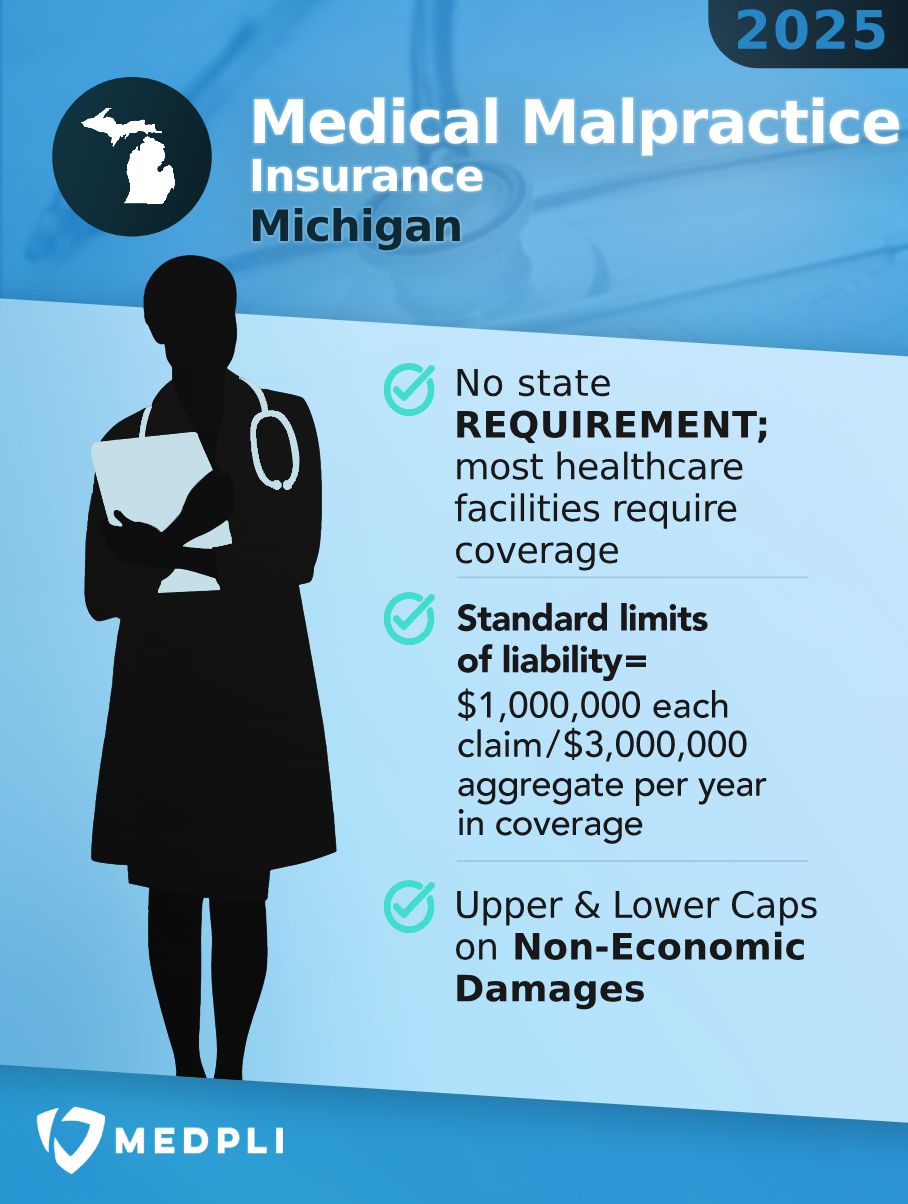Top 5 Malpractice Insurance Carriers in Michigan
We recommend carriers with an AM Best “A” or higher rating. An A-rating indicates financial strength, long-term solvency, and an established history of protecting Michigan physicians.

2025 Michigan Malpractice Insurance Rates by Specialty
These rate estimates are for informational purposes only and are based on the MI standard limits of $200,000 for Each Claim / $600,000 Aggregate per year in coverage.
Quotes require a completed application and underwriter approval. Contact us for a custom estimate if you don’t see your specialty.
| Specialty | 2025 Annual Premium |
2025 Tail Premium |
|---|---|---|
| Anesthesiology | $22,000 | $44,000 |
| Cardiovascular Disease– Minor Surgery | $31,000 | $62,000 |
| Dermatology– No Surgery | $12,000 | $24,000 |
| Emergency Medicine | $43,000 |
$86,000 |
| Family Practice– No Surgery | $19,000 | $38,000 |
| Gastroenterology– No Surgery | $23,000 | $46,000 |
| General Practice– No Surgery | $19,000 | $38,000 |
| General Surgery | $69,000 | $138,000 |
| Internal Medicine– No Surgery | $19,000 | $38,000 |
| Neurology– No Surgery | $22,000 |
$44,000 |
| Obstetrics and Gynecology– Major Surgery | $94,000 | $188,000 |
| Occupational Medicine | $12,000 | $24,000 |
| Ophthalmology– No Surgery | $12,000 | $24,000 |
| Orthopedic Surgery– No Spine | $55,000 | $110,000 |
| Pathology– No Surgery | $15,000 |
$30,000 |
| Pediatrics– No Surgery | $17,000 | $34,000 |
| Pulmonary Disease– No Surgery | $27,000 | $54,000 |
| Psychiatry | $12,000 | $24,000 |
| Radiology – Diagnostic | $30,000 | $60,000 |
Michigan Medical Malpractice Payouts From 2015-2023
Types of Professional Liability Insurance for Michigan Physicians
Physicians in Michigan can choose between these two primary types of medical malpractice insurance:

- Provides coverage for incidents that occurred during the policy period IF the claim is filed while the policy is still active. If a claim is filed after the policy ends, that claim is NOT covered.
- Typically, it offers lower premiums at the start of the policy, but rates increase yearly as the policy matures.
- Physicians must obtain tail insurance coverage when a claims-made policy ends to ensure protection against future claims related to incidents that occurred during the policy period. Tail insurance premiums require a one-time cash payment equal to approximately 200% of the claims-made policy’s annual premium.

- Provides coverage for incidents that occurred during the policy period, regardless of when a claim is reported to the carrier.
- Typically, it offers more costly premiums at the start of the policy, but the rate stays constant throughout the policy’s duration.
- Physicians do not need tail coverage when an occurrence policy ends.
In 2023, Michigan physicians were held liable for 179 medical malpractice payouts.
- Average Payout: $246,283
- Total Payout: $44,084,750
(Source: National Practitioner Data Bank)
Does Michigan Have Damage Caps for Medical Malpractice Lawsuits?
Michigan does not limit economic damages, though limitations on the total amount of noneconomic damages have been in place since the early 1990s. For each subsequent year, the state treasurer adjusts the limitation amounts to reflect annual fluctuations in the consumer price index.
Current Non-Economic Damage Caps:
- Lower Limit: $569,000 (All Injuries)
- Upper Limit: $1,016,000 (Exceptions Only)
Qualifying Exceptions for the Upper Limit:
- Permanent functional loss of one or more limbs caused either by a brain or spinal cord injury
- Permanent cognitive impairment
- Permanent loss or damage to a reproductive organ
Michigan Statute of Limitations for Medical Malpractice Claims
Michigan state law requires that medical malpractice claims be filed within a maximum of 6 years after the medical error and within these statutes of limitation, whichever is later:
- 6 months from date of discovery
Exceptions:
- Fraudulent conduct or concealment
- Permanent loss or damage to a reproductive organ
- Minor plaintiffs under the age of 8 can file an action up until their 10th birthday
- In cases that involve reproductive system injury, minor plaintiffs under the age of 13 can file an action up until their 15th birthday or within 2 years from the date of injury, whichever is later.
Why Michigan Doctors Partner with MEDPLI
We exclusively broker medical malpractice insurance, focusing daily on making the professional liability process less burdensome and expensive for doctors.
With MEDPLI, Michigan physicians:
MEDPLI helps doctors in every specialty.
Whether you’re a neurosurgeon in Detroit or run a MedSpa in Petoskey, MEDPLI will provide you with premier coverage at a competitive rate. Call 800-969-1339 or Request a Quote.





